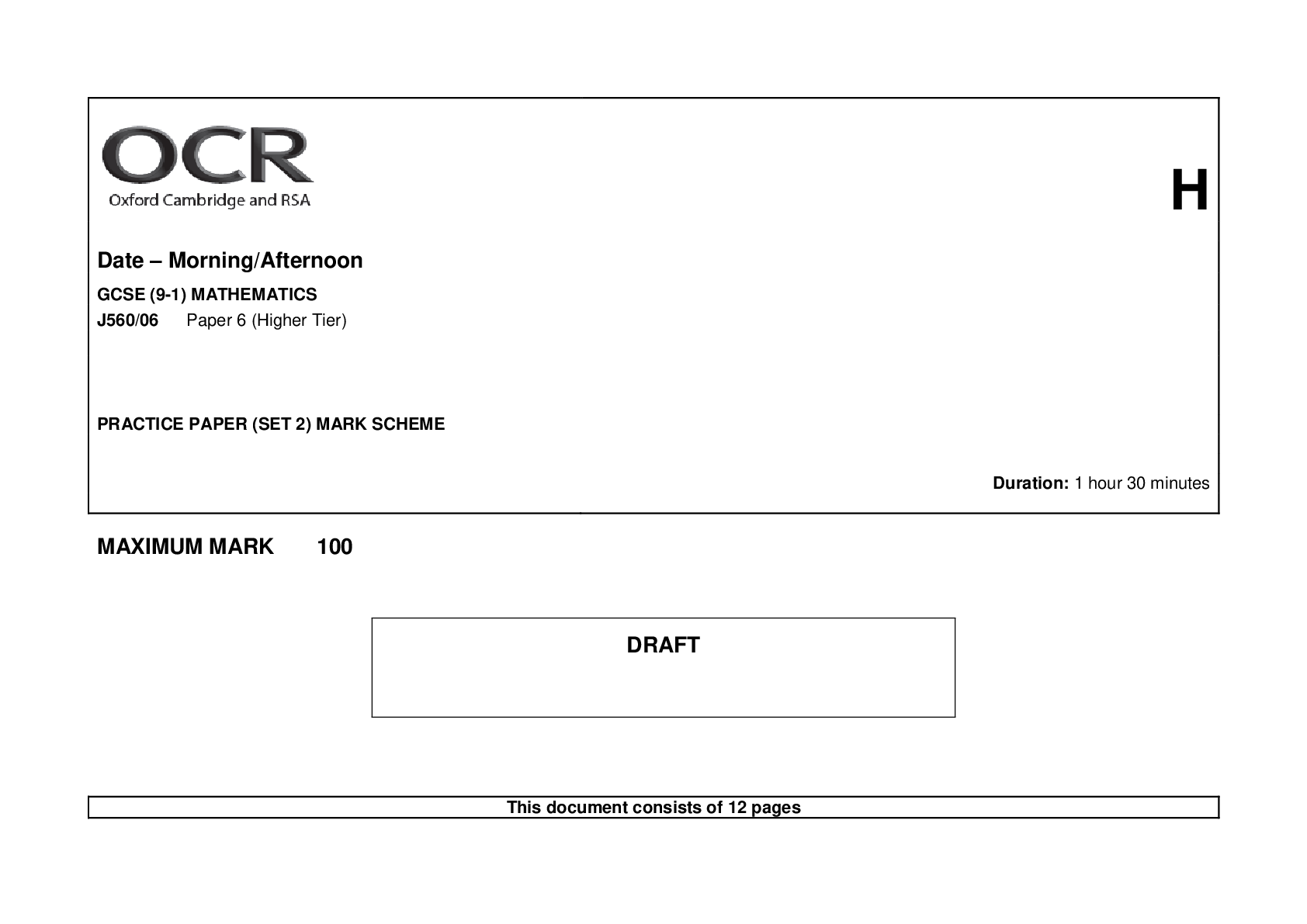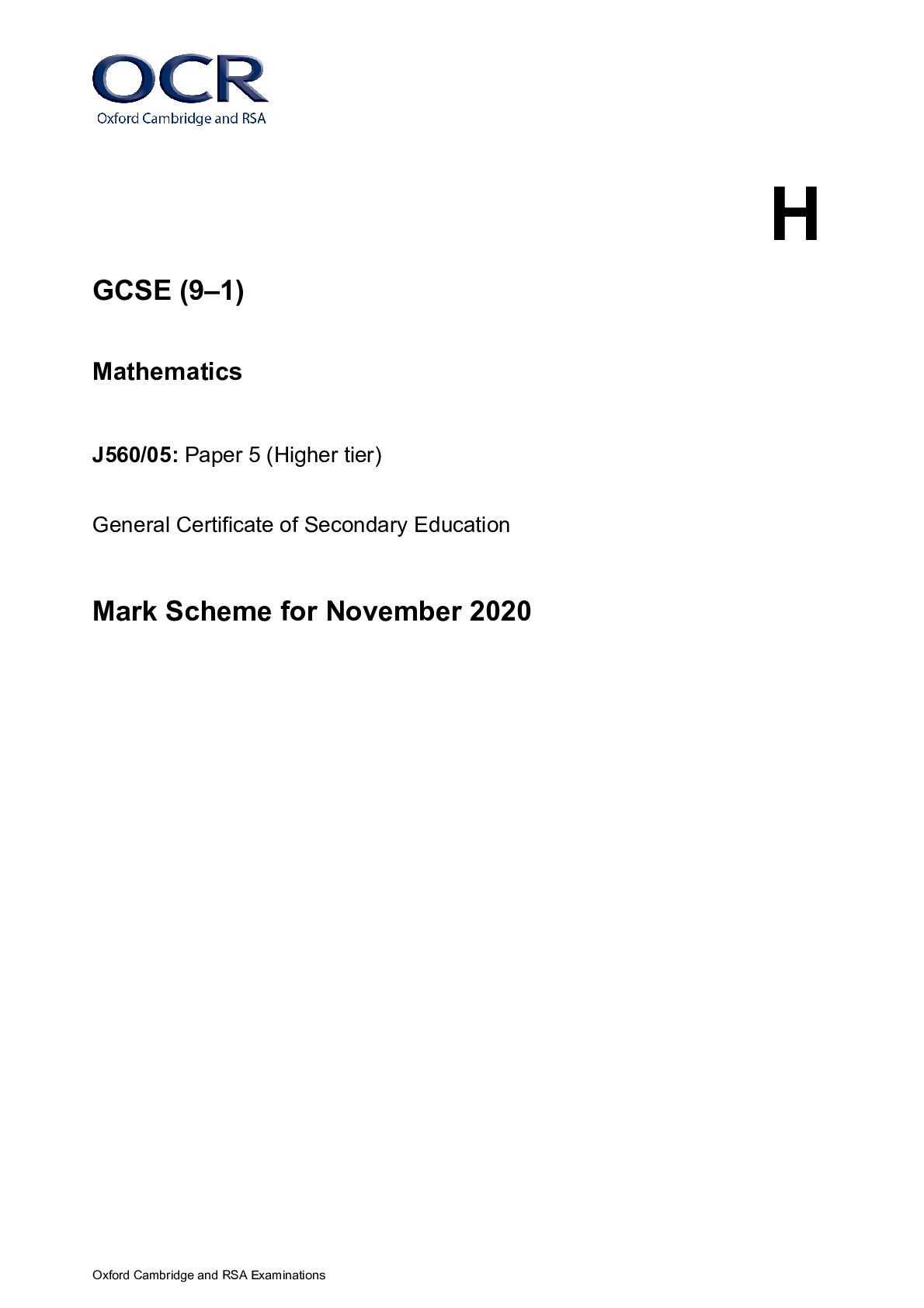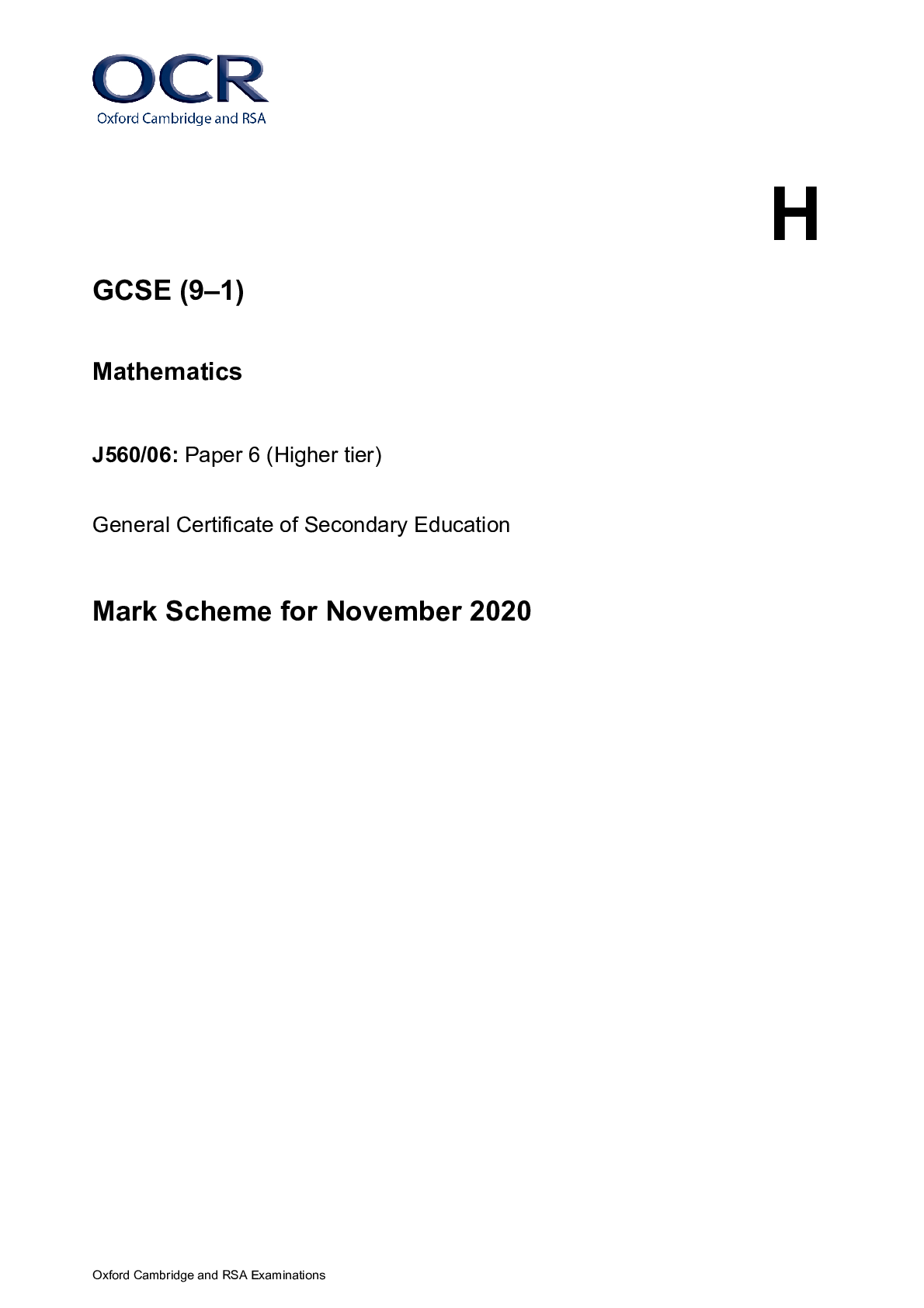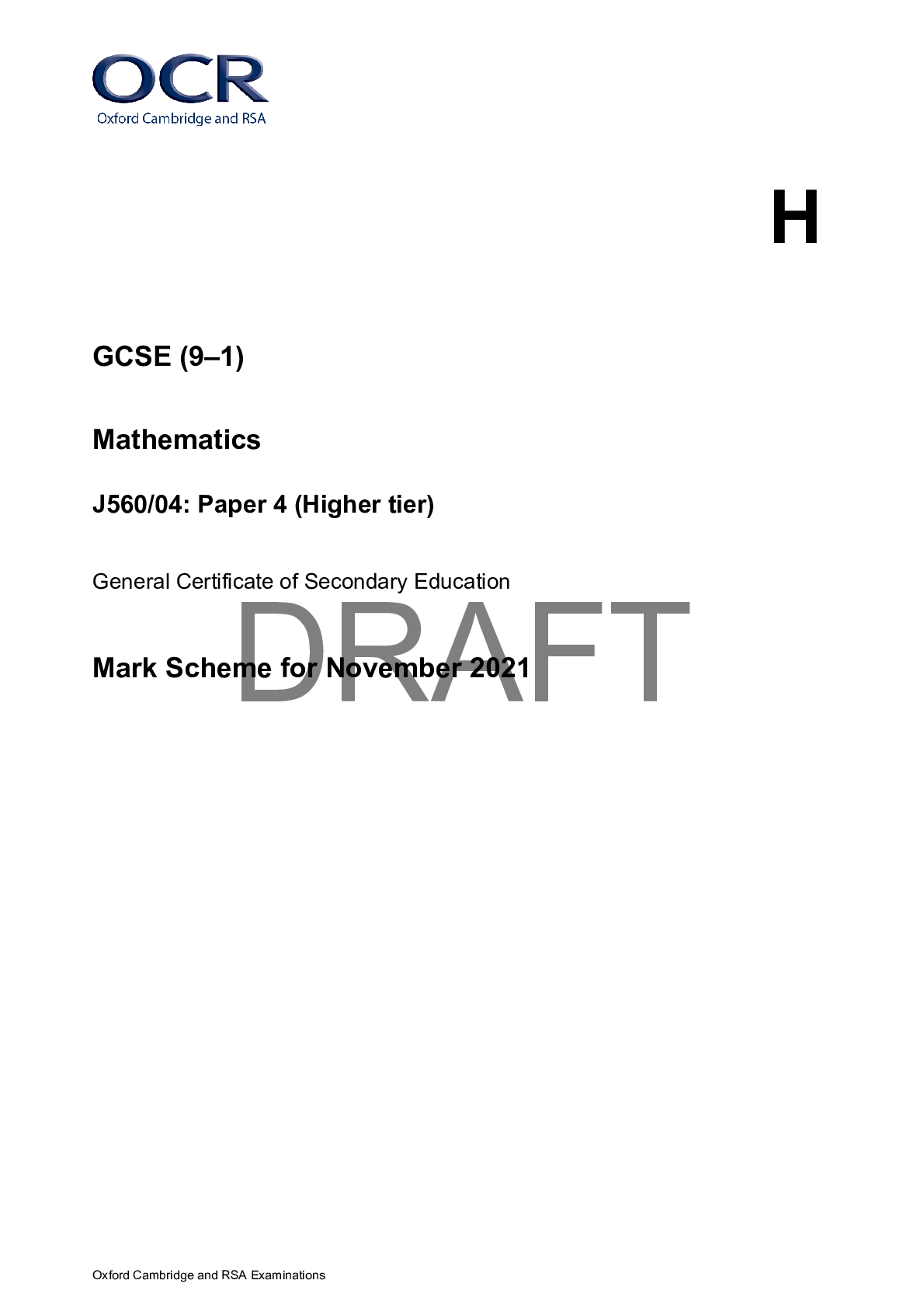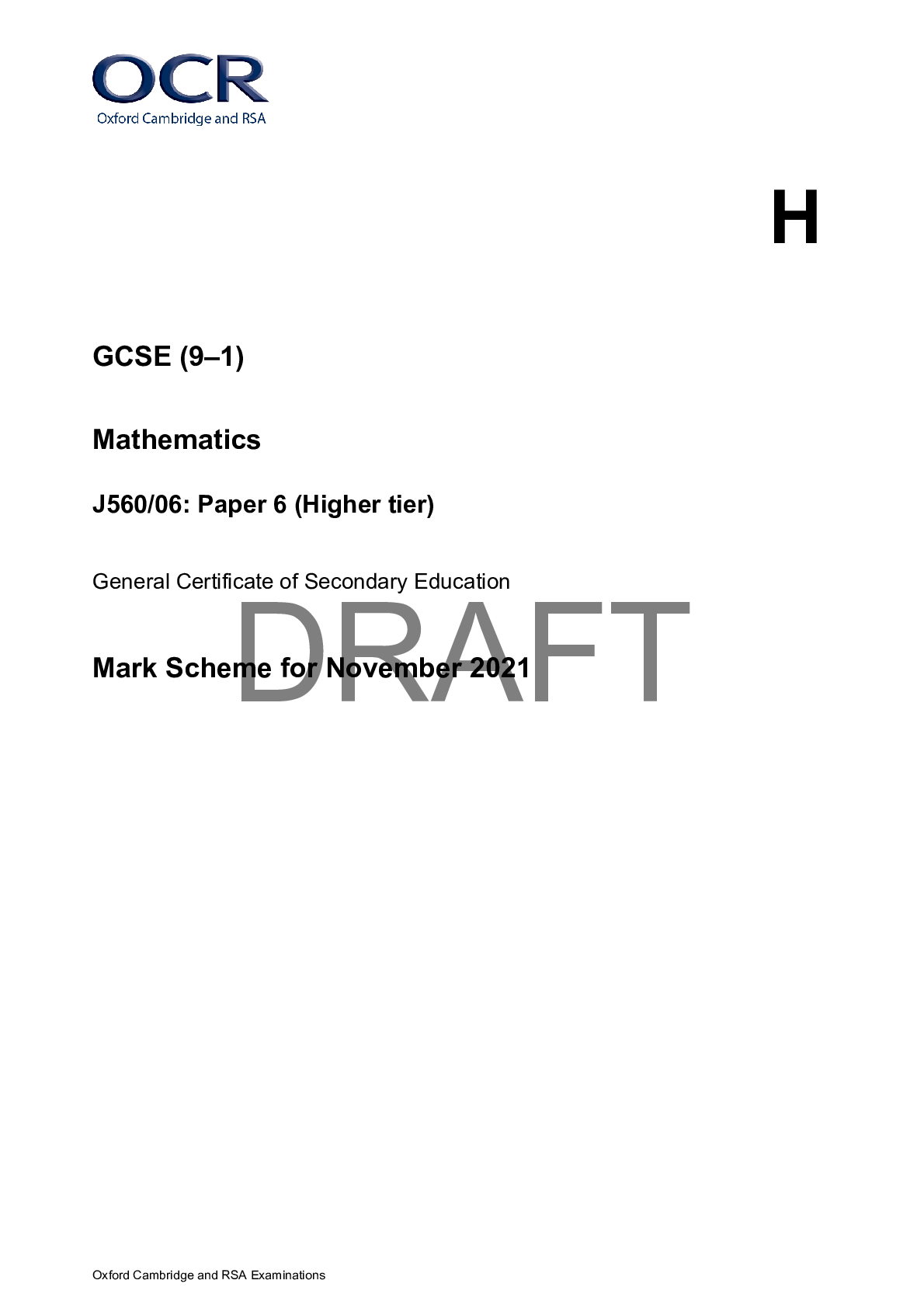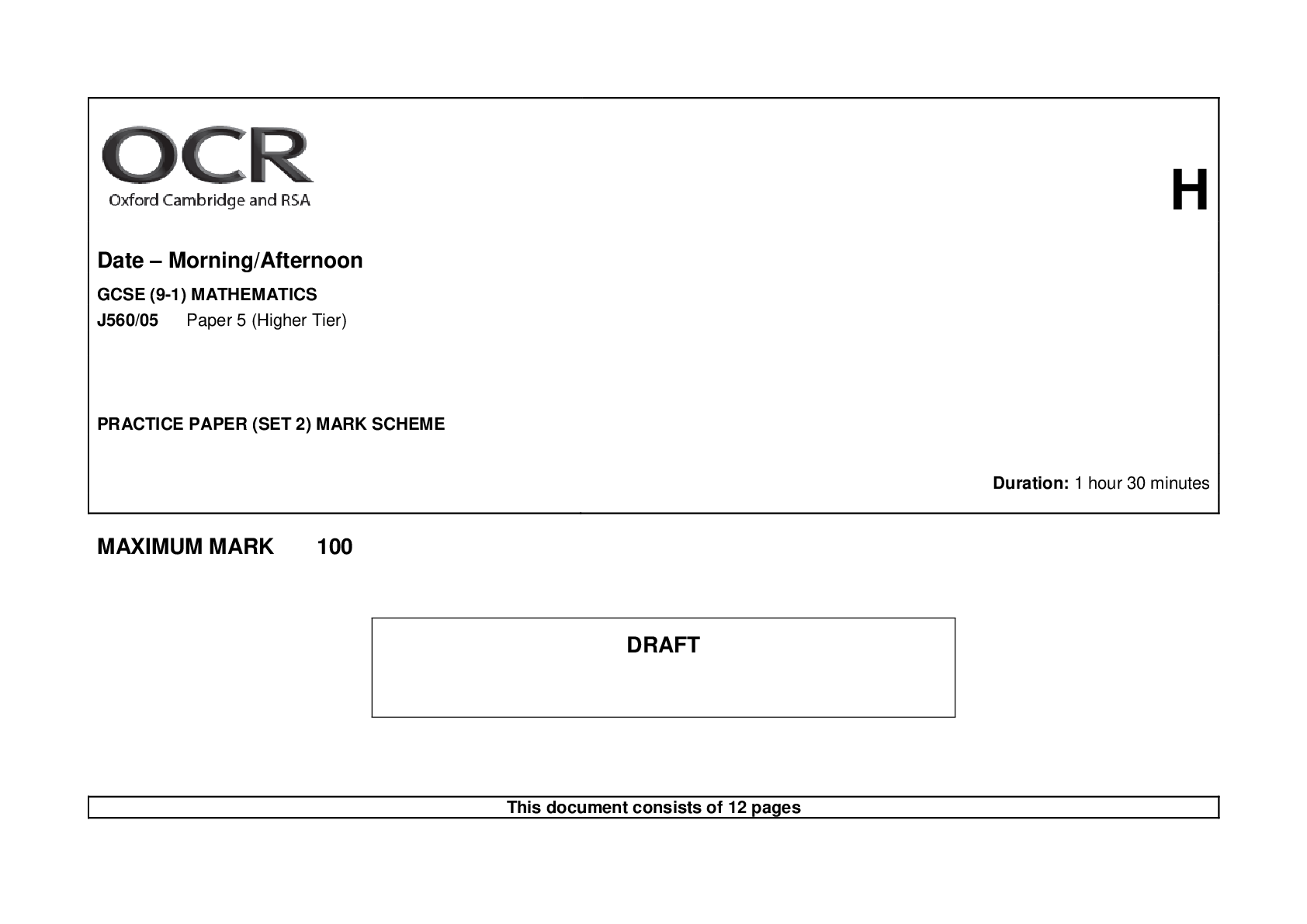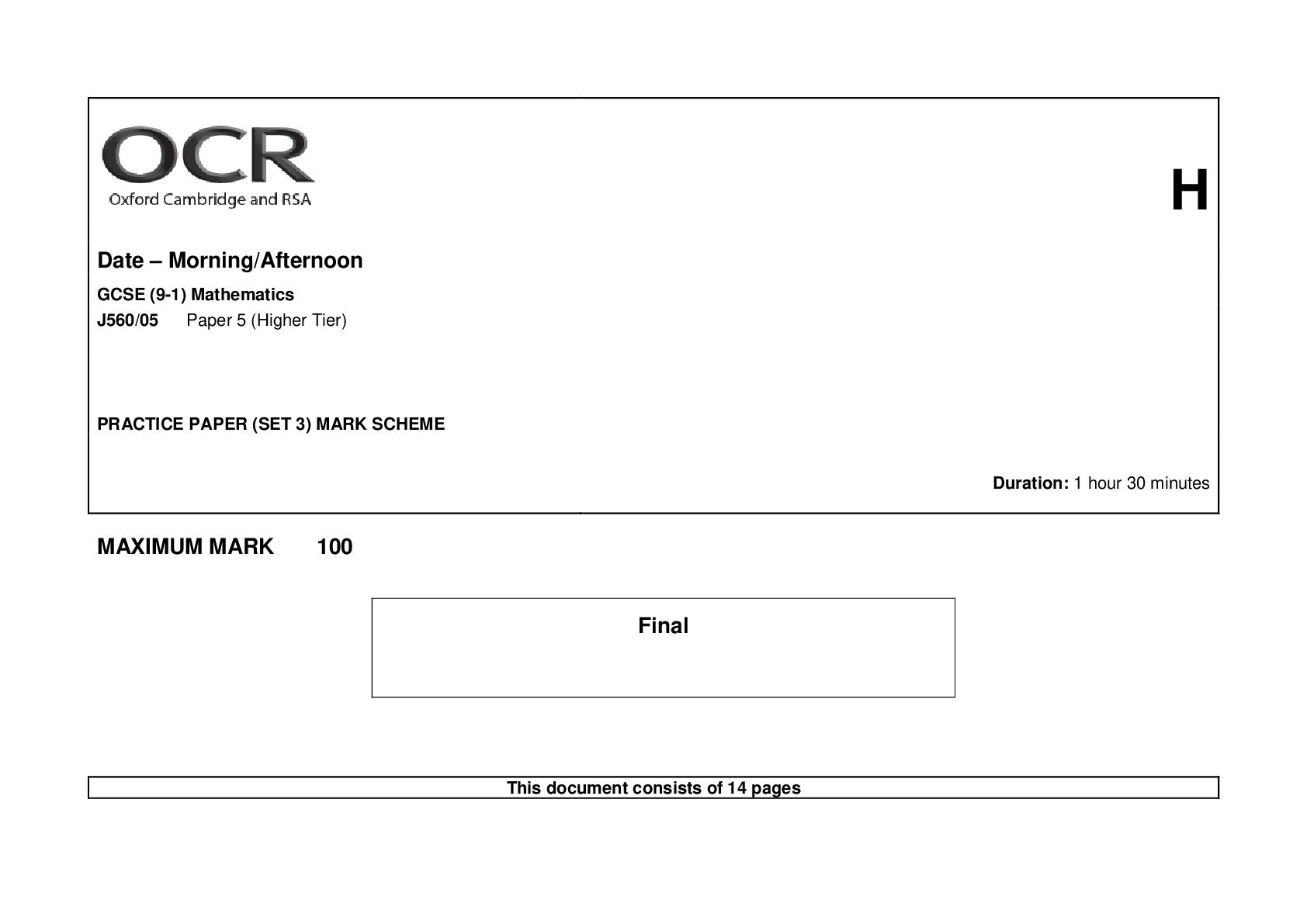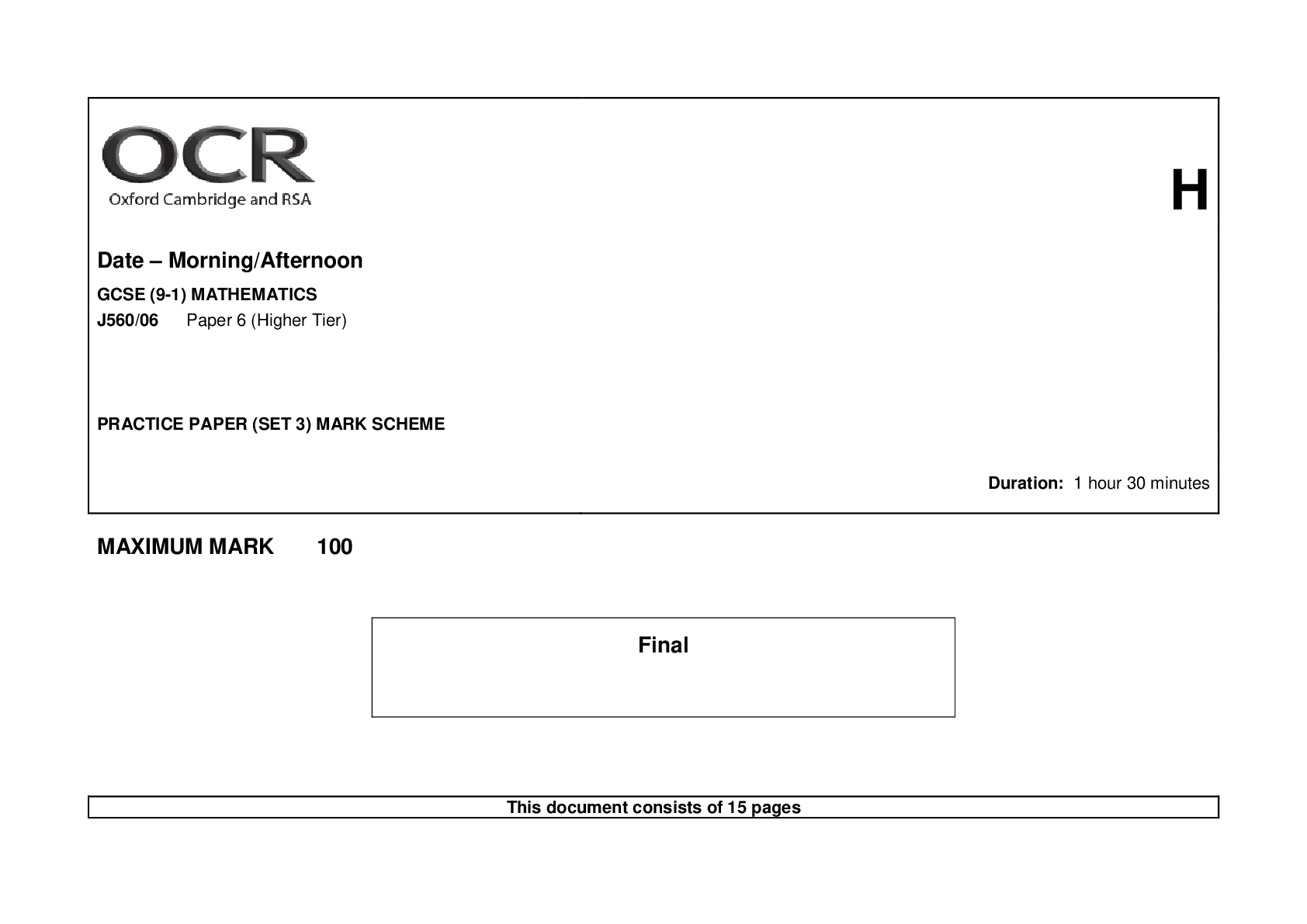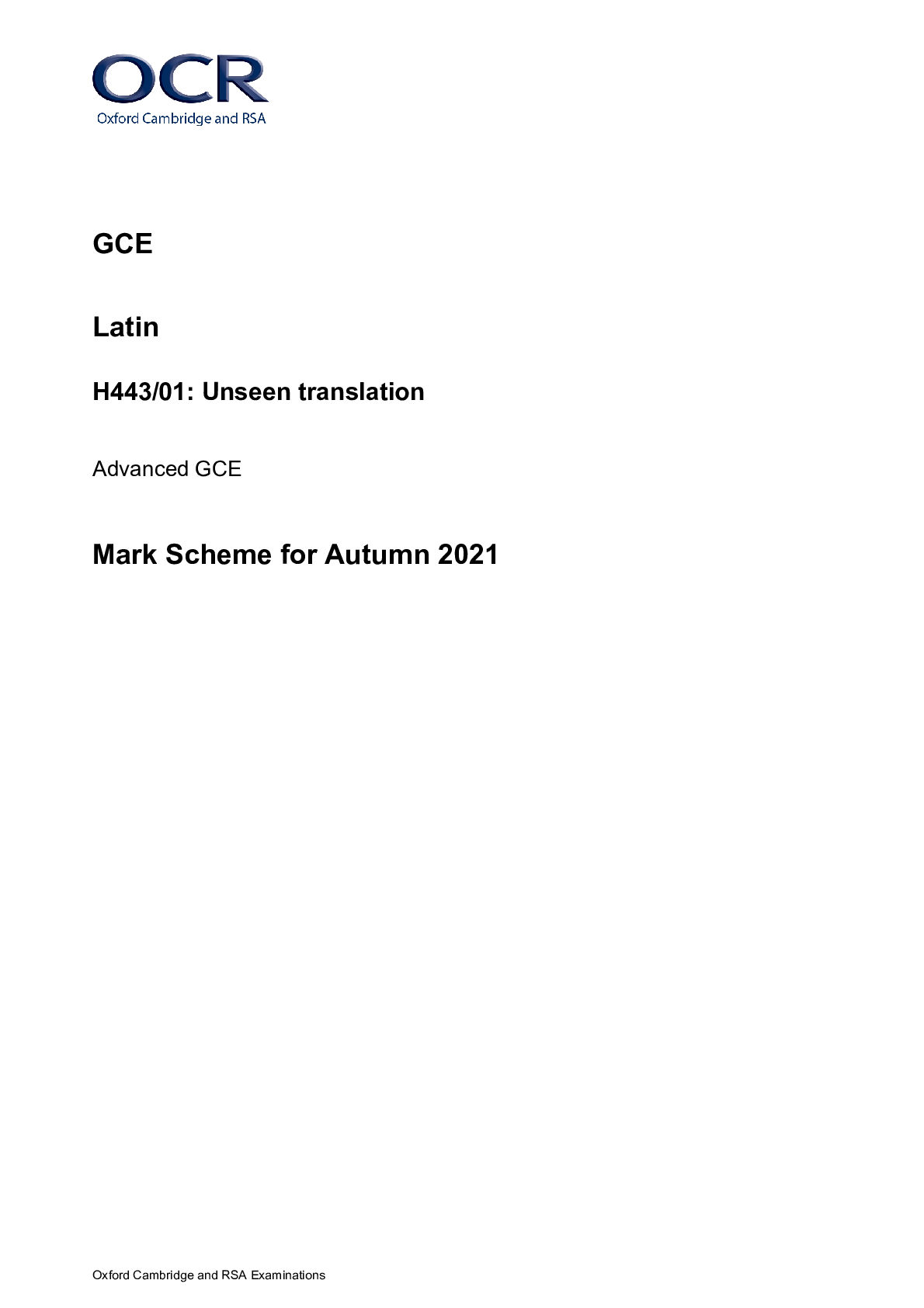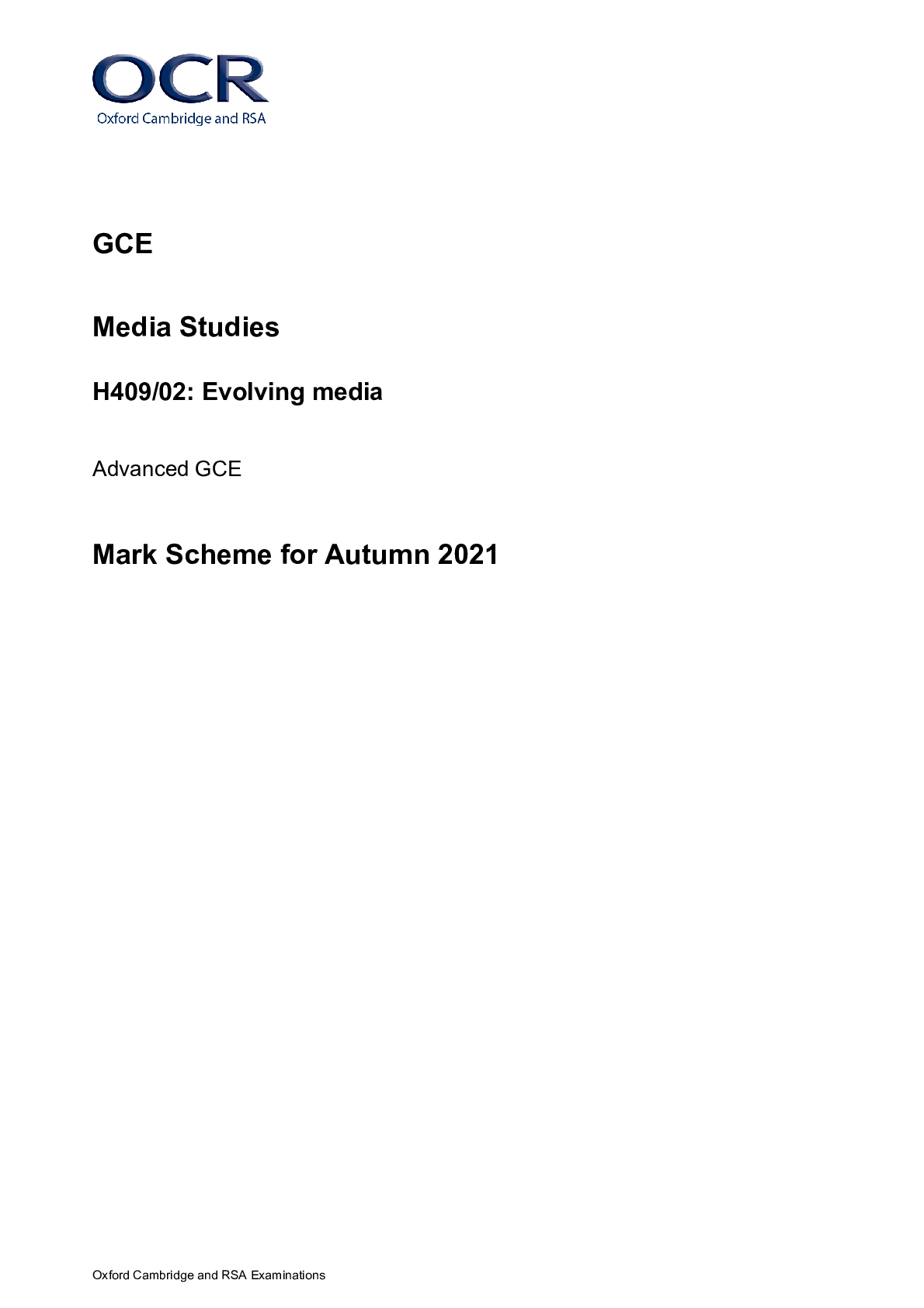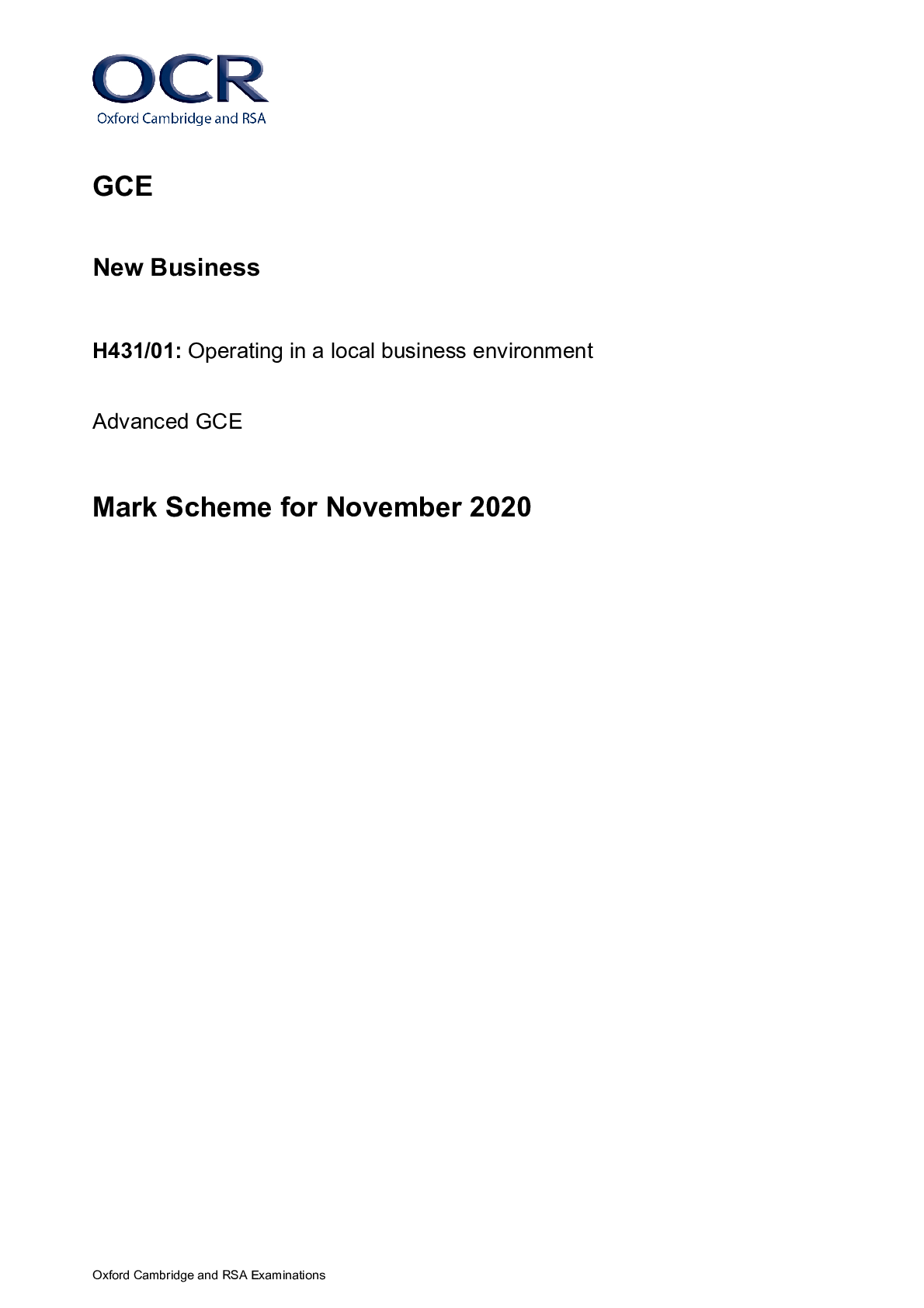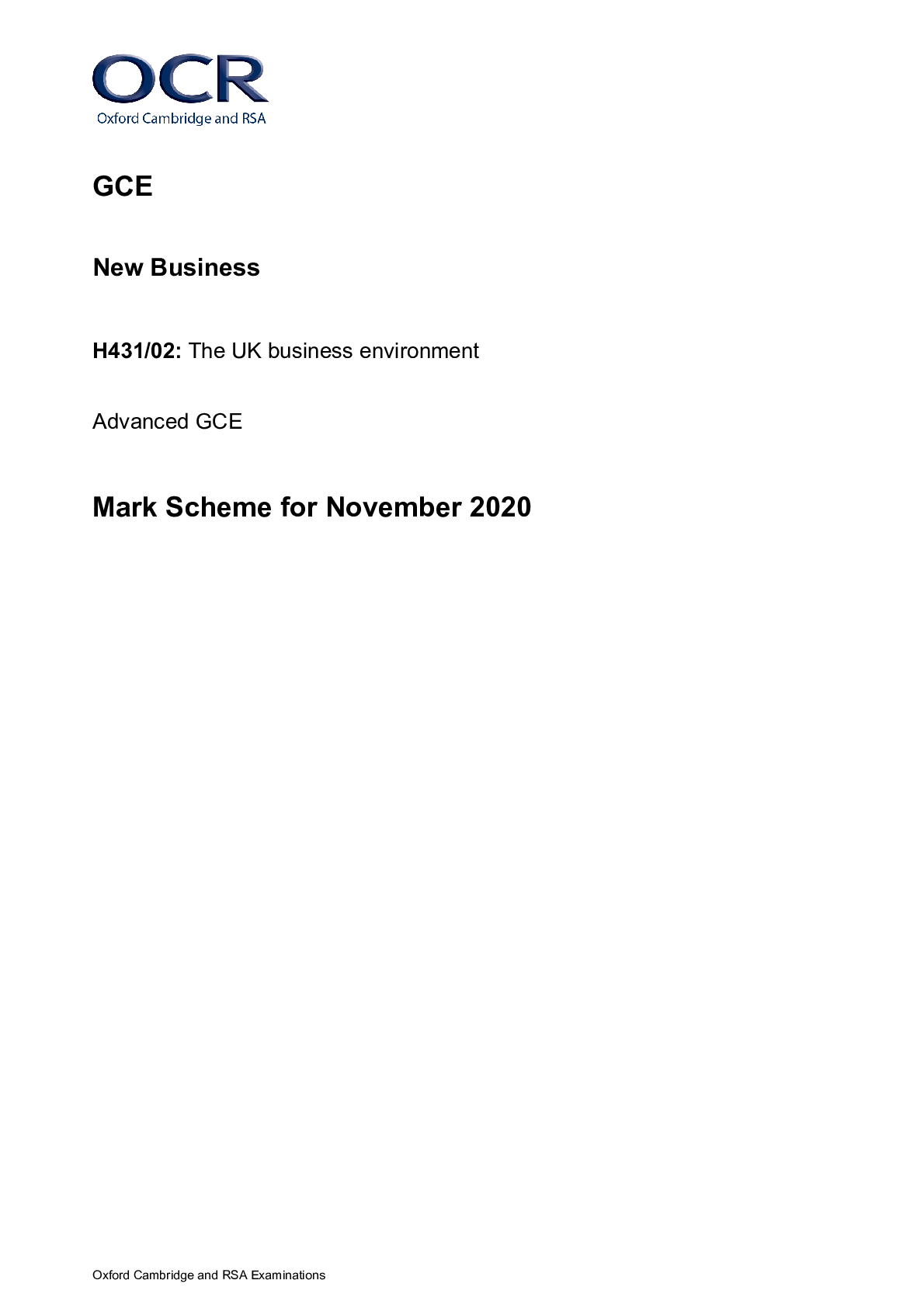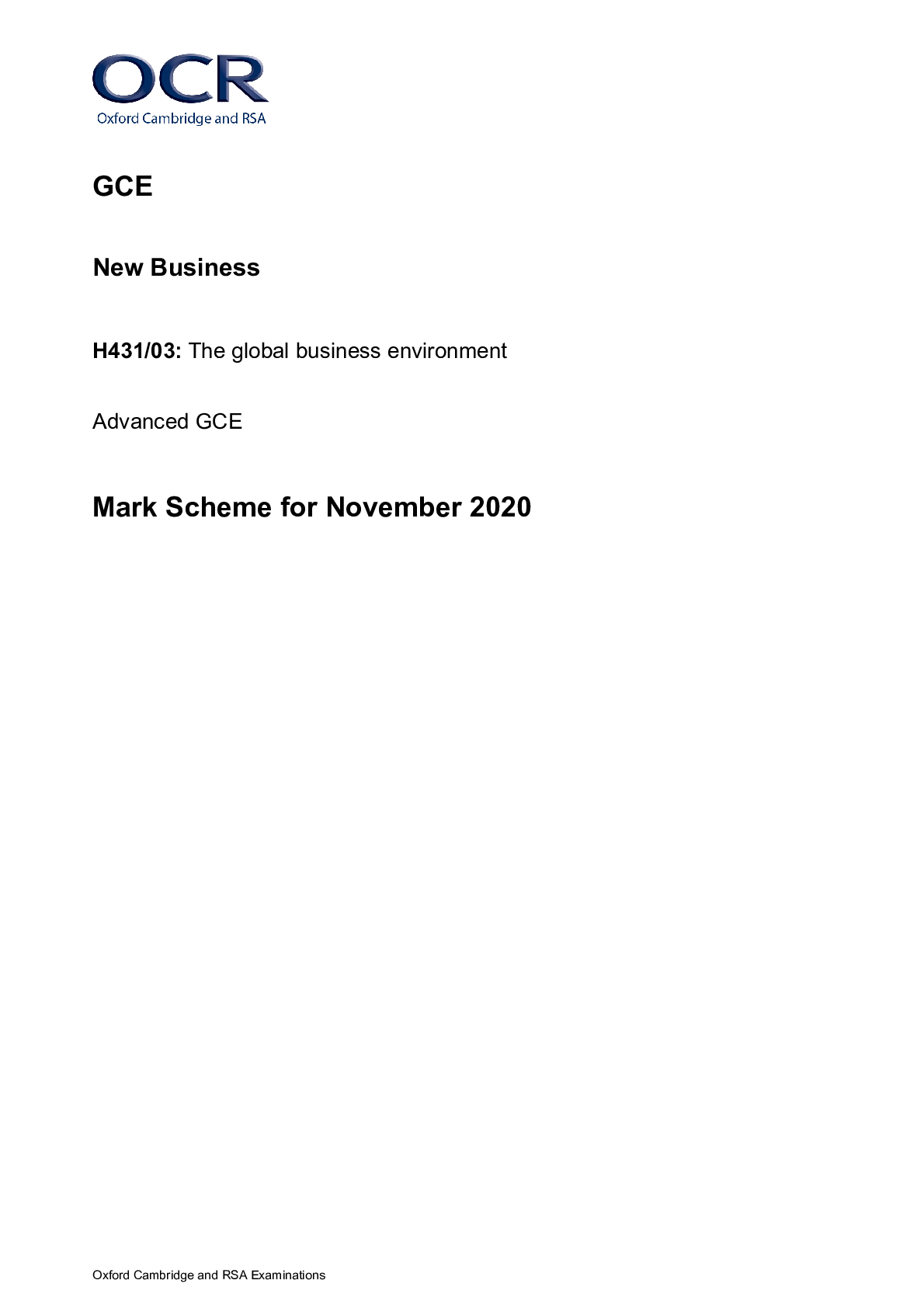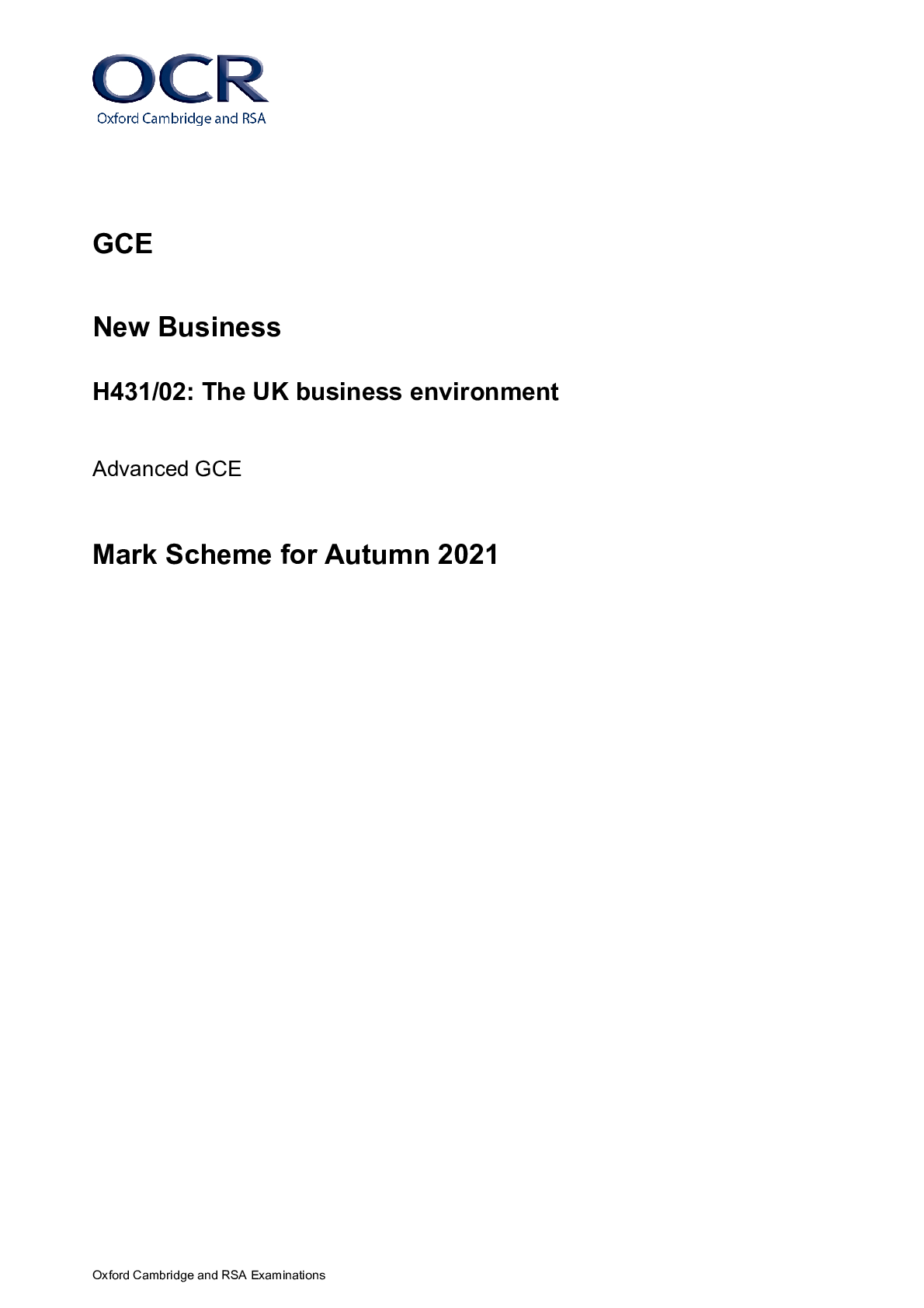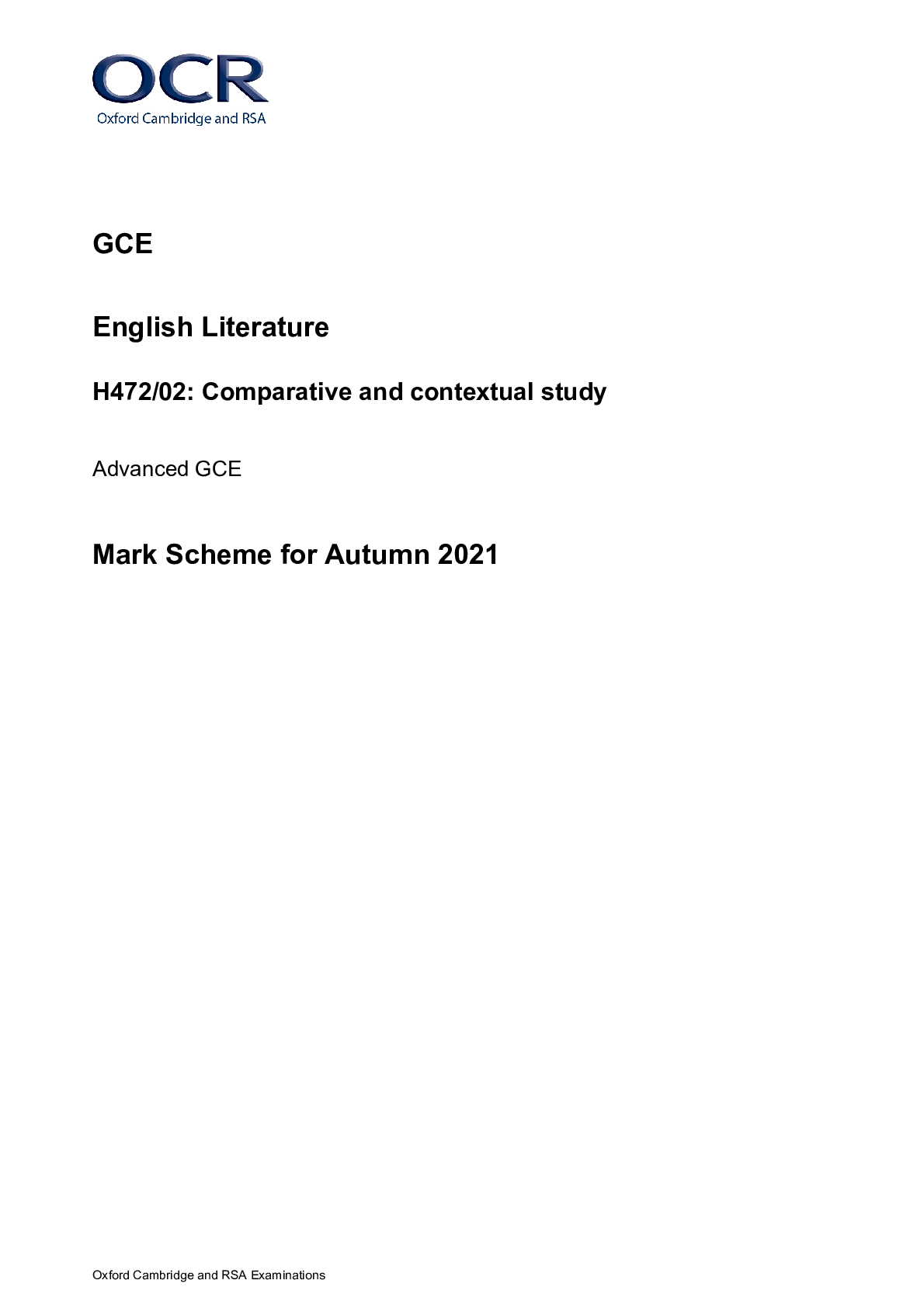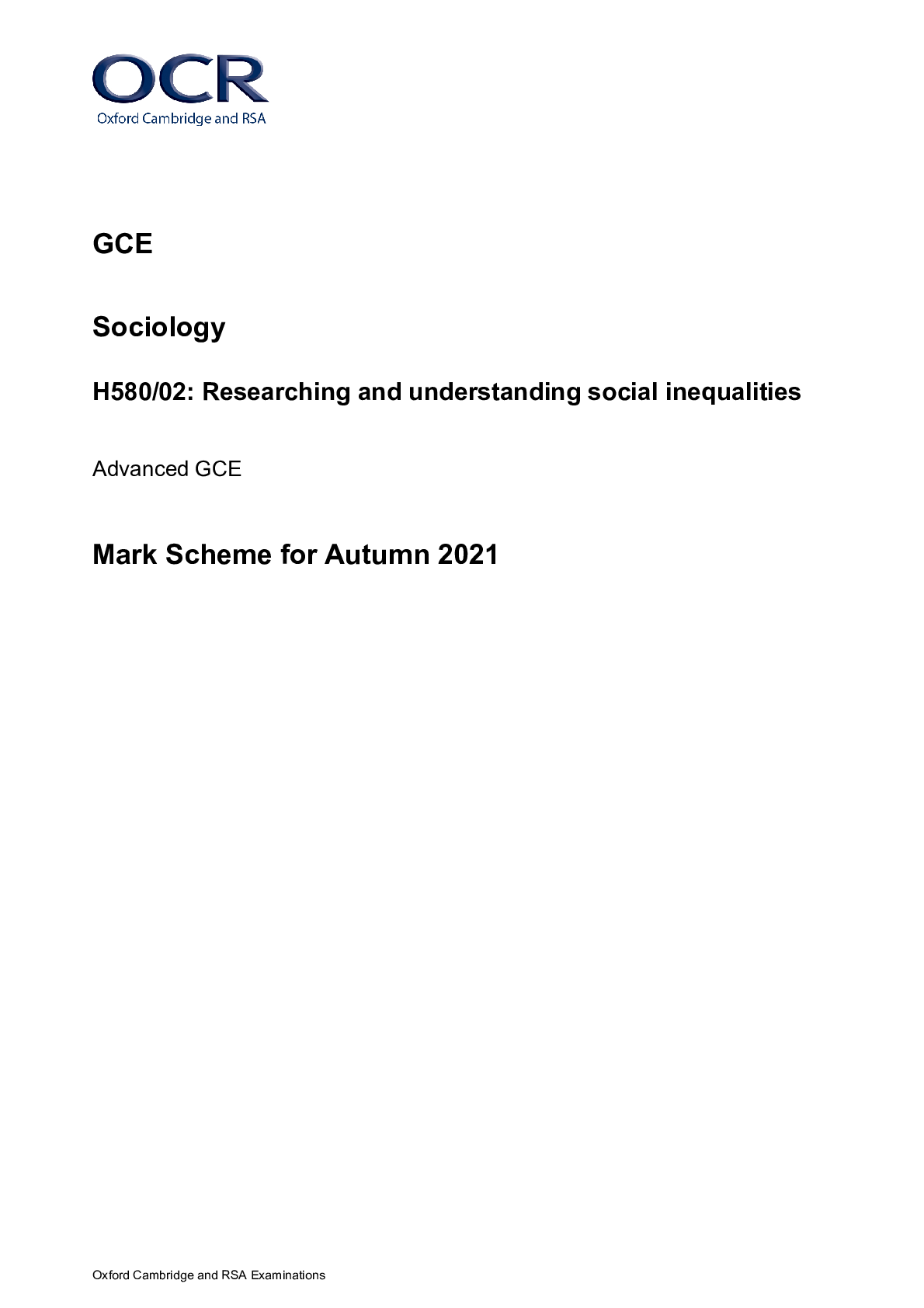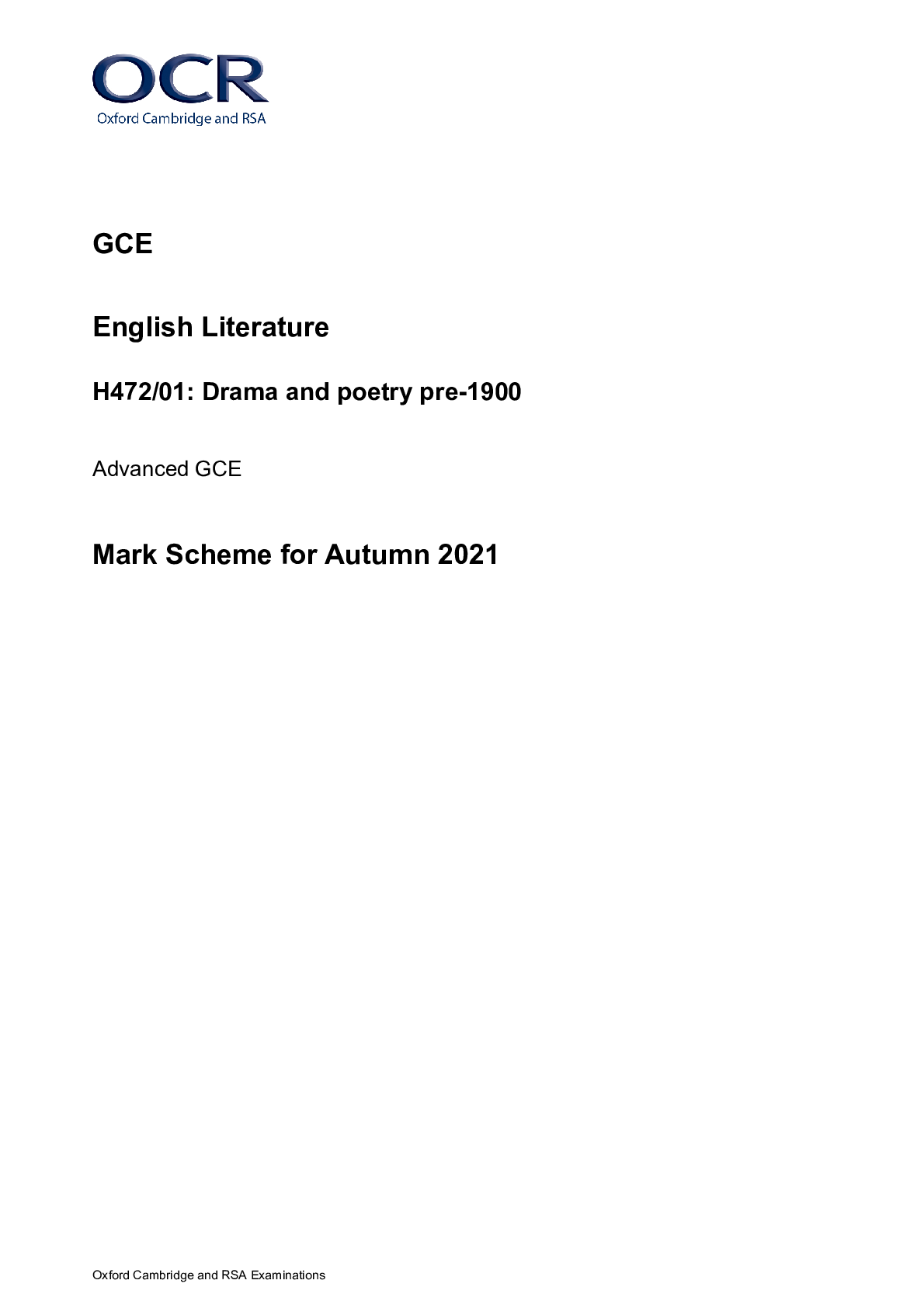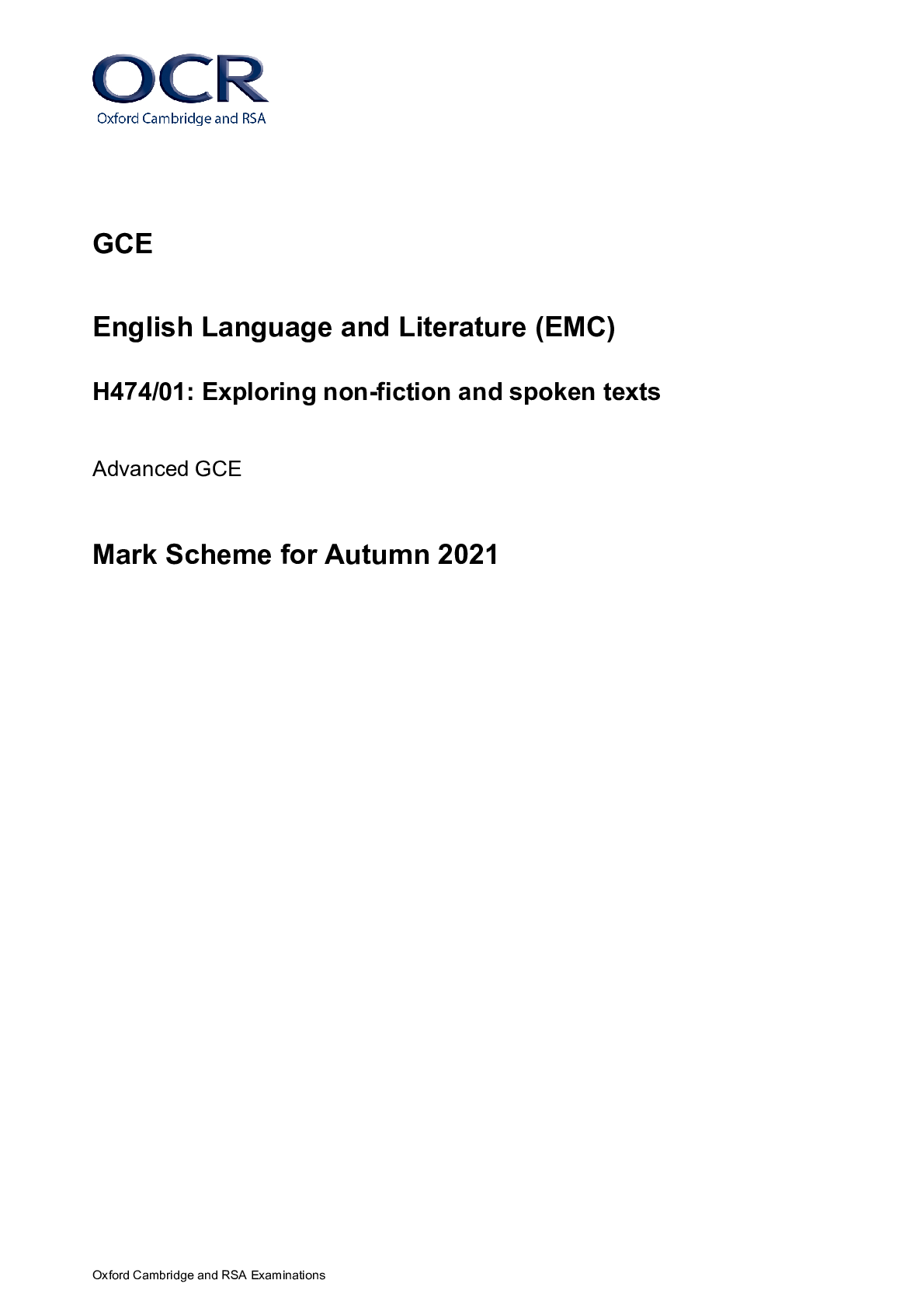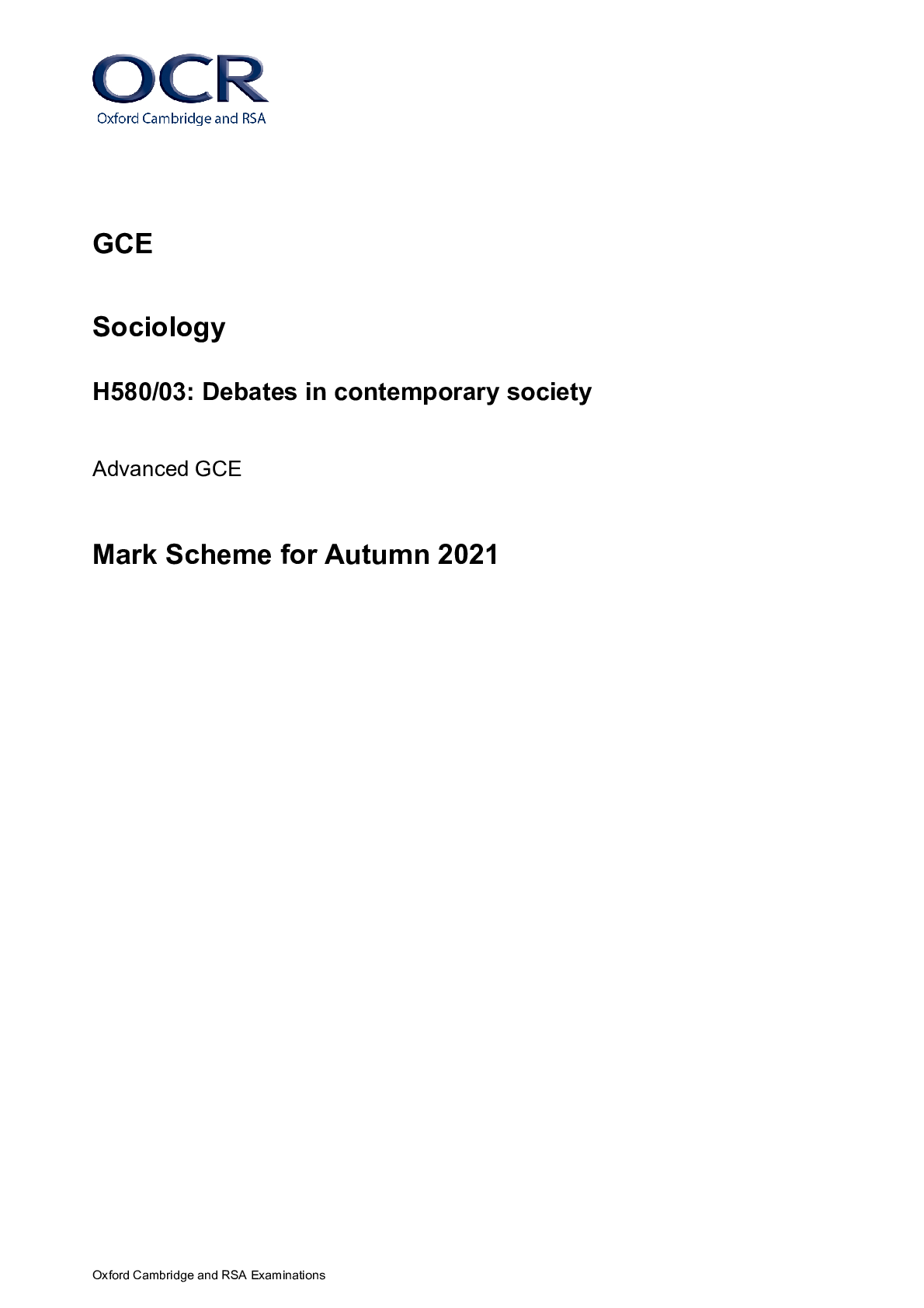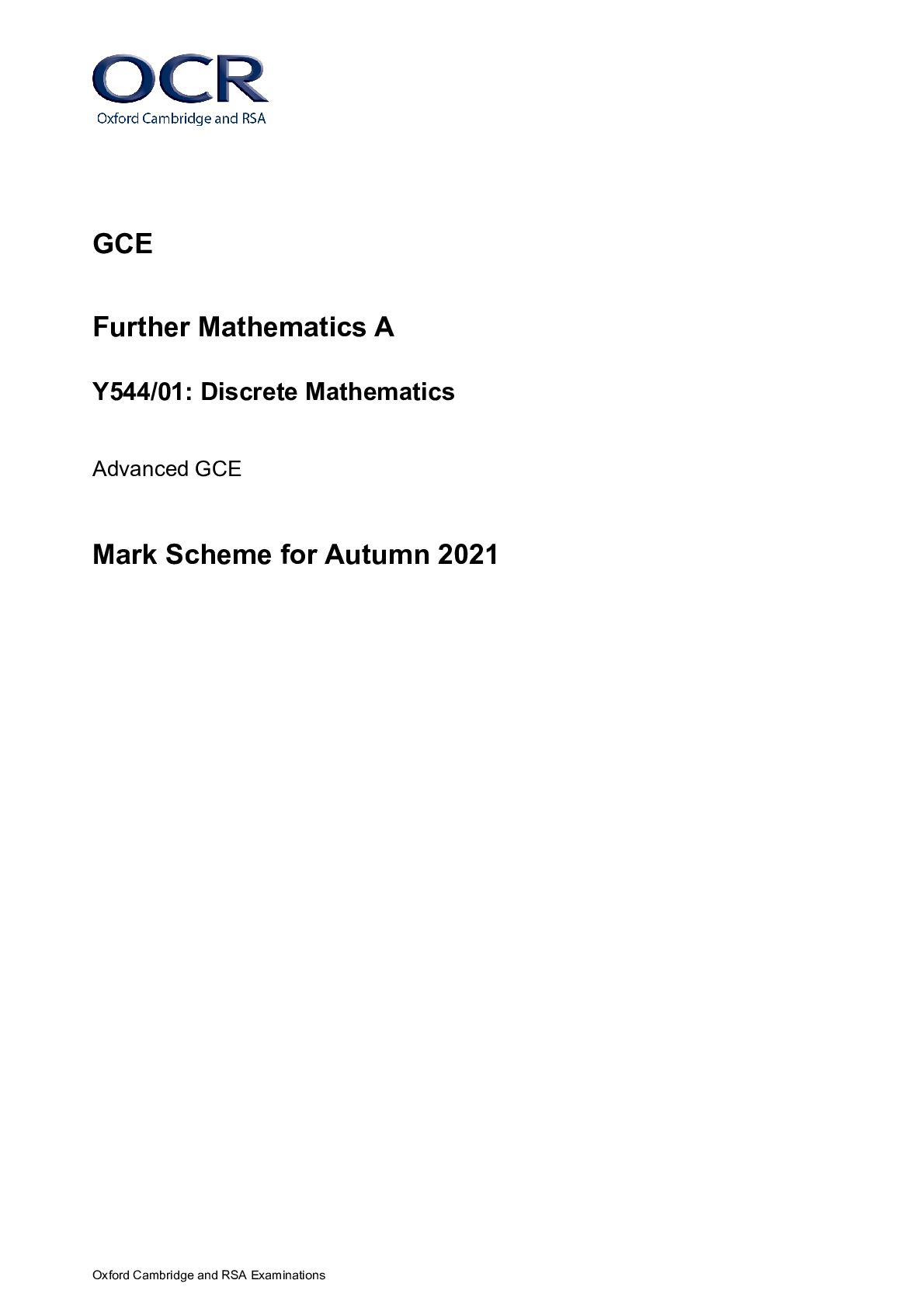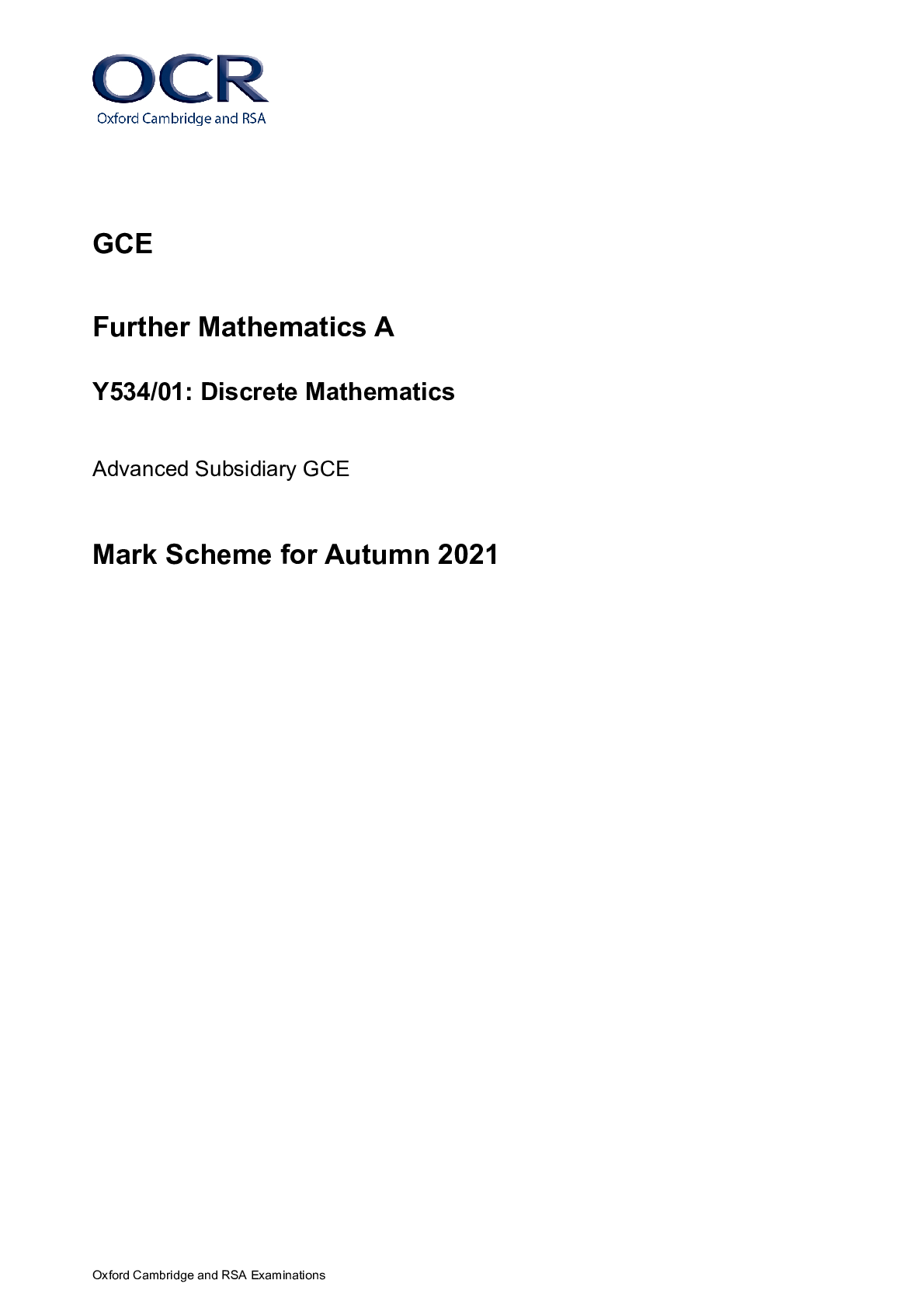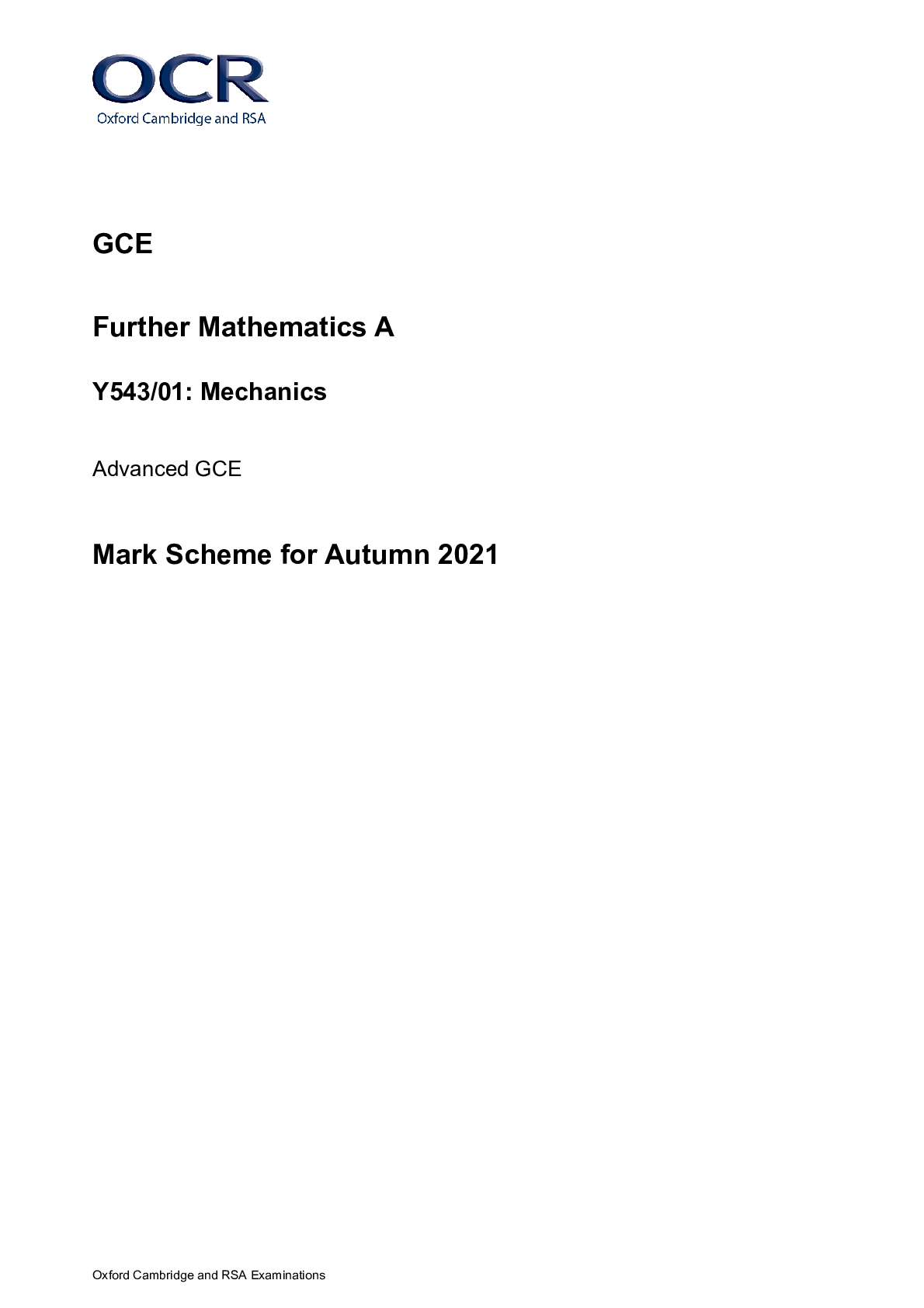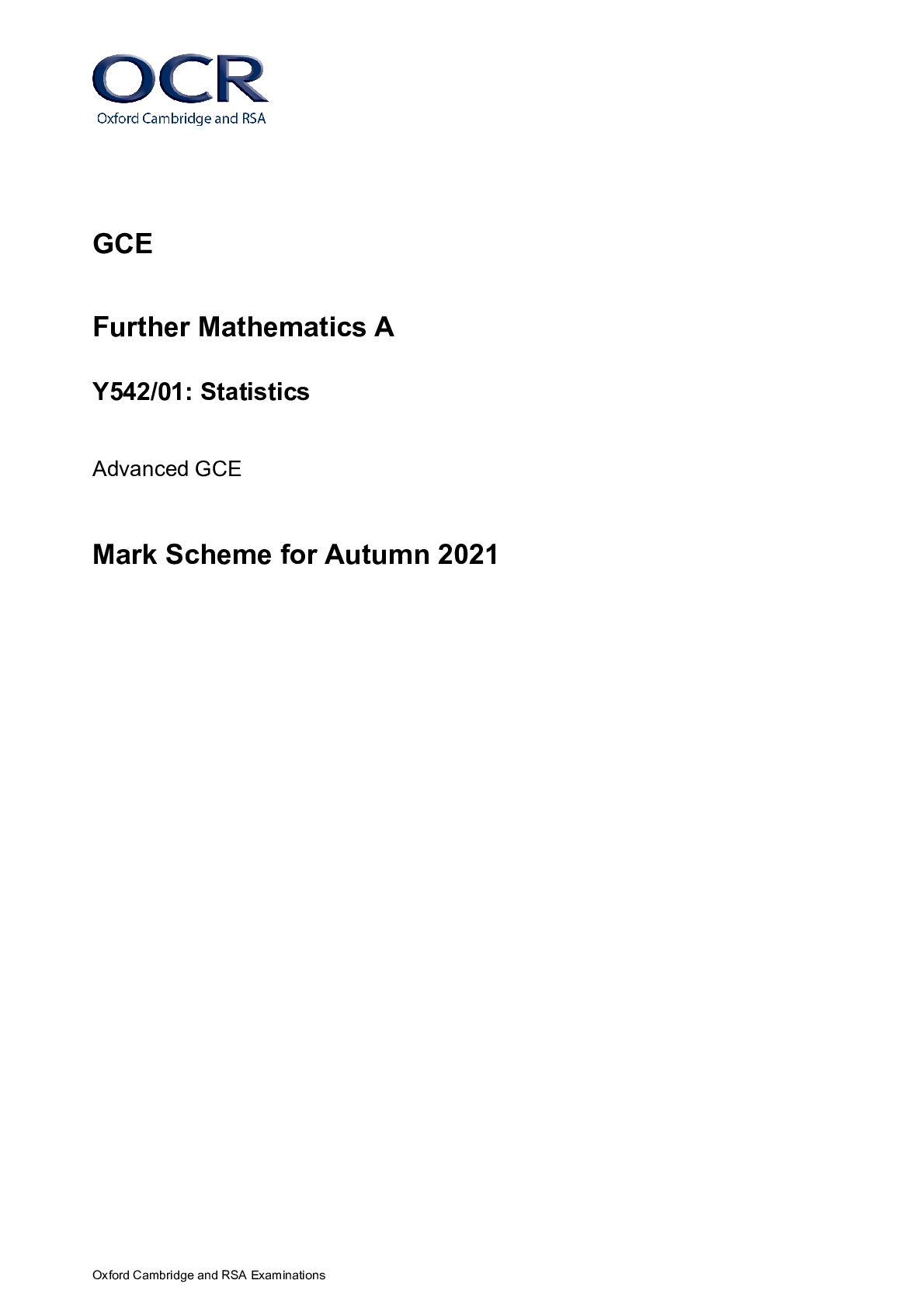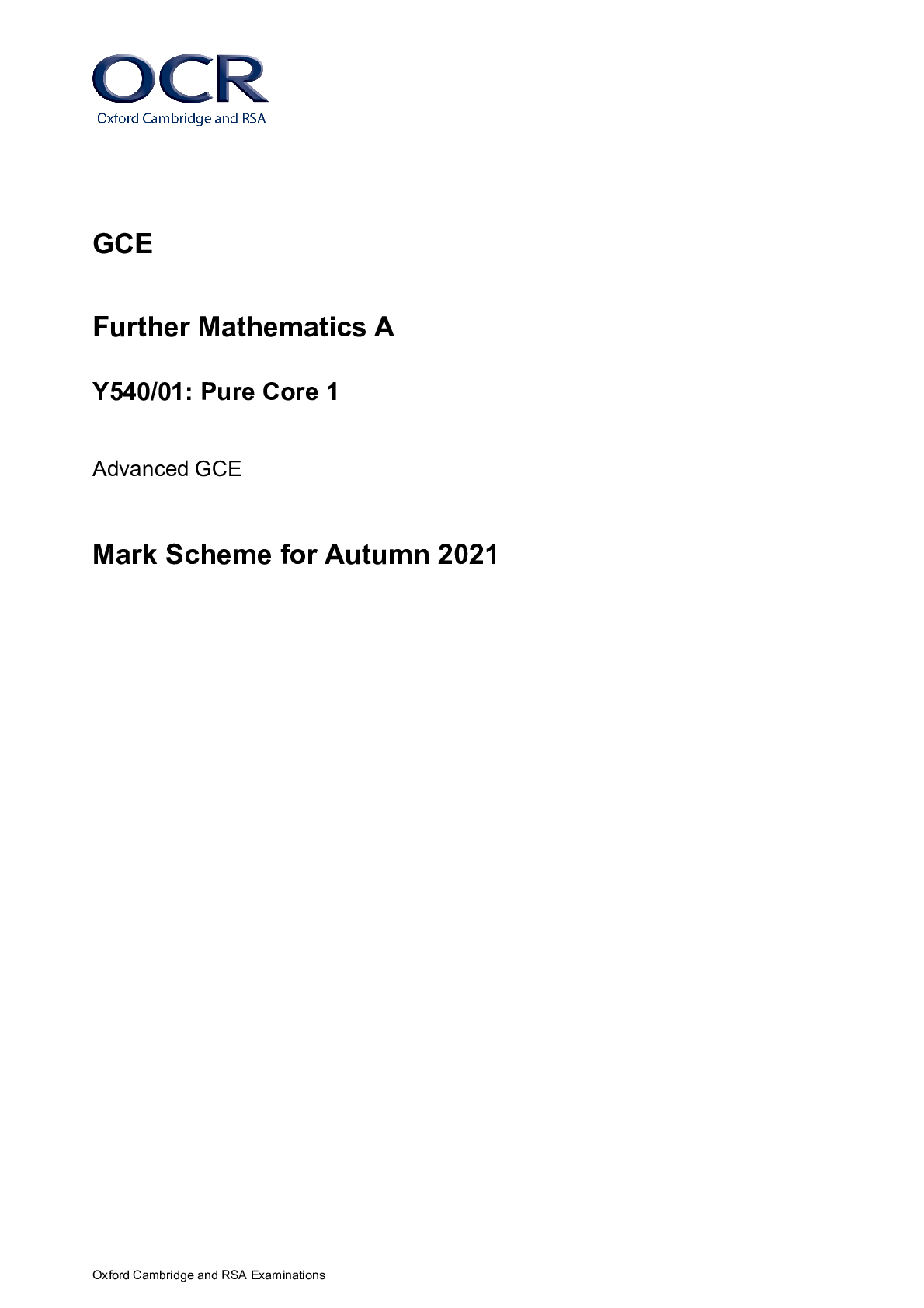History > MARK SCHEME > GCE History A Y222/01: The Cold War in Asia 1945-1993 Advanced GCE Mark Scheme for Autumn 2021 (All)
GCE History A Y222/01: The Cold War in Asia 1945-1993 Advanced GCE Mark Scheme for Autumn 2021
Document Content and Description Below
GCE History A Y222/01: The Cold War in Asia 1945-1993 Advanced GCE Mark Scheme for Autumn 2021 Oxford Cambridge and RSA Examinations GCE History A Y222/01: The Cold War in Asia 1945-1993 Ad... vanced GCE Mark Scheme for Autumn 2021Oxford Cambridge and RSA Examinations OCR (Oxford Cambridge and RSA) is a leading UK awarding body, providing a wide range of qualifications to meet the needs of candidates of all ages and abilities. OCR qualifications include AS/A Levels, Diplomas, GCSEs, Cambridge Nationals, Cambridge Technicals, Functional Skills, Key Skills, Entry Level qualifications, NVQs and vocational qualifications in areas such as IT, business, languages, teaching/training, administration and secretarial skills. It is also responsible for developing new specifications to meet national requirements and the needs of students and teachers. OCR is a not-for-profit organisation; any surplus made is invested back into the establishment to help towards the development of qualifications and support, which keep pace with the changing needs of today’s society. This mark scheme is published as an aid to teachers and students, to indicate the requirements of the examination. It shows the basis on which marks were awarded by examiners. It does not indicate the details of the discussions which took place at an examiners’ meeting before marking commenced. All examiners are instructed that alternative correct answers and unexpected approaches in candidates’ scripts must be given marks that fairly reflect the relevant knowledge and skills demonstrated. Mark schemes should be read in conjunction with the published question papers and the report on the examination. © OCR 2021Y222/01 Mark Scheme October 2021 2 1. Annotations Annotation Meaning of annotation Blank Page Highlight Off-page comment Assertion Analysis Evaluation Explanation Factor Illustrates/Describes Irrelevant, a significant amount of material that does not answer the question Judgement Knowledge and understanding Provenance Simple comment Unclear ViewY222/01 Mark Scheme October 2021 3 Question Answer Mark Guidance 1 (a) Which of the following was of greater importance as a reason for the fall of China to Communism in 1949? (i) The failings of Jiang Jieshi and the Guomindang (GMD) (ii) The leadership of Mao Zedong Explain your answer with reference to both (i) and (ii). • In dealing with the failings of the GMD, • Answers might argue that the army was undermined by corruption which left the soldiery short of food and equipment. • Answers might argue that desertion was a major problem. • Answers might argue that Jiang’s conscription policies hit the peasants hardest and encouraged many to switch allegiance to the CCP. • Answers might argue that Jiang made many strategic errors. • Answers might argue that Jiang did not trust his generals. • Answers might argue that communist spies were able to infiltrate the GMD. • In dealing with the leadership of Mao Zedong, answers might argue that his economic and social policies were popular and won support. • Answers might argue Mao was flexible in changing policies to maintain support. • Answers might argue that Mao’s resistance to the Japanese convinced people that he was a true 10 • No set answer is expected • Judgement must be supported by relevant and accurate material. • Only credit material relevant to question. • Answers may deal with each factor in turn, then compare them to reach a judgement, or take a continually comparative approach. Either approach is acceptable. • Knowledge must not be credited in isolation, it should only be credited where it is used as the basis for analysis and evaluation, in line with descriptions in the levels mark scheme.Y222/01 Mark Scheme October 2021 4 1 (b)* nationalist. • Answers might argue that Mao was well served by competent generals, such as Lin Biao, whom he trusted. • Answers might argue that Mao’s willingness to engage with the peasantry and listen to their concerns, won support. • Answers might argue that Mao’s propaganda was effective. ‘The weakness of South Vietnam was the main reason for the escalation of US involvement in Vietnam from 1965.’ How far do you agree? • In arguing that the weakness of South Vietnam was the main reason, answers might argue that political instability (a succession of military coups since Diem’s death in November 1963) meant that government lacked direction and consistency of purpose. • Answers might argue that Nguyen Cao Ky, PM from June 1965, was hopelessly inept. • Answers might explain that the slowness with which government operated was frustrating to Americans. • Answers might argue that the US was irritated by the inability of South Vietnam to check VC attacks on US bases and men. • Answers might argue that South Vietnam’s military was incompetent and ill-equipped. • Answers might argue that South Vietnam’s economy was not strong enough to support the war effort. • Answers might argue communist forces were increasing in strength and threatening the survival of South Vietnam. 20 • No set answer is expected. • At higher levels candidates will focus on ‘how far’ but at Level 4 may simply list factors • At Level 5 there will be judgement as to the weakness of South Vietnam. • At higher levels candidates might establish criteria against which to judge the weakness of South Vietnam. • To be valid judgements, claims must be supported by accurate and relevant material, if not they are assertions. • Knowledge must not be credited in isolation, it should only be credited where it is used as the basis for analysis and evaluation in line with the descriptions in the levels mark scheme.Y222/01 Mark Scheme October 2021 5 2 (a) • In arguing that other reasons were important, answers might argue that Johnson was overly combative, arrogant and over confident which encouraged him to escalate US involvement. • Answers might argue that it was fear of the consequences of the collapse of South Vietnam based on the domino theory. • Answers might argue that escalation was due to the Cold War struggle and was necessary for the US to prove its leadership of the free world. • Answers might explain that the Joint Chiefs of Staff and the executive believed the war could be won by heavy bombing of the North which would mean escalation. • Answers might argue that the US was reacting to the Gulf of Tonkin incident. • Answers might argue that Congress supported escalation and was prepared to vote extra funds for the purpose. Which of the following policies of the Khmer Rouge, was the most destructive during the period 1975 to 1978? (i) The evacuation to the rural areas (ii) Anti-intellectualism Explain your answer with reference to both (i) and (ii). • In dealing with the evacuation to the rural areas, answers might explain that 2 million were deported from Phnom Penh alone. • Answers might explain that even those in hospitals were evacuated. 10 • No set answer is expected • Judgement must be supported by relevant and accurate material. • Only credit material relevant to question. • Answers may deal with each factor in turn, then compare them to reach a judgement, or take a continually comparative approach. Either approach is acceptable.. • Knowledge must not be credited in isolation, it should only be credited where it is used as the basis for analysis and evaluation, in line with descriptions in the levels mark scheme.Y222/01 Mark Scheme October 2021 6 2 (b)* • Answers might explain that evacuees were worked like slaves in labour camps. • Answers might explain that 650,000 evacuees died. • Answers might argue that the evacuations led to the collapse of services in towns. • Answers might argue that the economy was undermined. • In dealing with anti-intellectualism, answers might explain that between 500,000 and 1 million Cambodians with an education were executed. • Answers might argue that 80% of teachers were executed so the education system collapsed. • Answers might argue that 95% of doctors were killed which meant there was little healthcare in the country. • Answers might argue that the death of journalists and writers removed any dissent or challenge to the regime. • Answers might argue that the murder of public servants at national and local administration meant that government was paralysed. • Answers might explain that anti-intellectualism was so pernicious that people with qualifications disguised their identity. 20 • No set answer is expected.Y222/01 Mark Scheme October 2021 7 To what extent was the USA responsible for the outbreak of the Korean War? • In arguing that the USA was responsible for the outbreak of the Korean War, answers might argue that the US supported the unpopular regime of Syngman Rhee. • Answers might argue that the US had not included Korea in their Defensive Perimeter Strategy. • Answers might argue that some US politicians made speeches that suggested the US would accept a communist takeover of Korea. • Answers might argue that the rejection by Congress of a bill for aid to Korea signalled a lack of support for Korea. • Answers might argue that the small number of US advisers in Korea was inadequate. • Answers might argue that US diplomacy towards the USSR was uncompromising and made it difficult for the USSR to consider the resolution of differences between the US and the USSR, including Korea. • In arguing that other factors were responsible for the outbreak of the Korean War, answers might argue that responsibility lay with Syngman Rhee who wanted to unite the country under his leadership and who initiated border clashes, 1948- 49. • Answers might argue that Rhee was encouraged by Chiang-Kai-Shek: both feared China and regarded a war as a way of forcing the US to extend its containment policy to the whole Pacific area. • Answers might argue that responsibility lay with North Korea as Kim Il Sung was also ambitious to lead a united Korea and he attacked the South in • At higher levels candidates will focus on ‘to what extent’ but at Level 4 may simply list factors • At Level 5 there will be judgement as to the USA’s responsibility for the war. • At higher levels candidates might establish criteria against which to judge US responsibility. • To be valid judgements, claims must be supported by accurate and relevant material, if not they are assertions. • Knowledge must not be credited in isolation, it should only be credited where it is used as the basis for analysis and evaluation in line with the descriptions in the levels mark scheme.Y222/01 Mark Scheme October 2021 8 June 1950. • Answers might argue that the USSR was responsible for the war as they provided Kim with tanks, aircraft and advisers. • Answers might discuss Stalin’s possible motives especially fears about China expanding its influence in Korea.Y222/01 Mark Scheme October 2021 9 APPENDIX 1 – this contains a generic mark scheme grid AO1: Demonstrate, organise and communicate knowledge and understanding to analyse and evaluate the key features related to the periods studied, making substantiated judgements and exploring concepts, as relevant, of cause, consequence, change, continuity, similarity, difference and significance. Generic mark scheme for Question 1(a) and Question 2(a): Which of the following? [10] Level 6 9–10 marks Both factors are thoroughly analysed and evaluated using accurate and detailed knowledge and understanding of key features of the period, in order to reach a developed and substantiated judgement in relation to the question. Level 5 7–8 marks Both factors are analysed and evaluated using generally accurate and detailed knowledge and understanding of key features of the period, in order to reach a substantiated judgement in relation to the question. Level 4 5–6 marks Both factors are analysed and evaluated using relevant knowledge and understanding of key features of the period, however treatment of factors may be un-even with analysis and evaluation of one of the two being only partial. Analysis and evaluation is used to support a reasonable judgement in relation to the question. Level 3 3–4 marks Both factors are analysed and evaluated in a partial way, using some relevant knowledge of key features of the period, in order to make a basic judgement in relation to the question. Level 2 2 marks Limited and generalised knowledge of the period is used to attempt a limited analysis or evaluation of both factors, and this is linked to a very simplistic judgement. Level 1 1 mark Very limited and generalised knowledge of the period is used to attempt a very limited analysis or evaluation of one of the factors. The other factor is either not considered or there is very limited information or description of the factor with no attempt to use this knowledge. If there is a judgement, this takes the form of assertion. 0 marks Nothing of any relevance to the factors.Y222/01 Mark Scheme October 2021 10 AO1: Demonstrate, organise and communicate knowledge and understanding to analyse and evaluate the key features related to the periods studied, making substantiated judgements and exploring concepts, as relevant, of cause, consequence, change, continuity,similarity, difference and significance. Generic mark scheme for Question 1(b) and Question 2(b): Essay [20] Level 6 17–20 marks There is a consistent focus on the question throughout the answer. Accurate and detailed knowledge and understanding is demonstrated throughout the answer and is consistently evaluated and analysed in order to reach substantiated, developed and sustained judgements. There is a well-developed and sustained line of reasoning which is coherent and logically structured. The information presented is entirely relevant and substantiated. Level 5 13–16 marks There is a mostly consistent focus on the question. Generally accurate and detailed knowledge and understanding is demonstrated through most of the answer and is evaluated and analysed in order to reach substantiated judgements, but these are not consistently well-developed. There is a well-developed line of reasoning which is clear and logically structured. The information presented is relevant and in the most part substantiated. Level 4 10–12 marks The question is generally addressed. Generally accurate and sometimes detailed knowledge and understanding is demonstrated through most of the answer with evaluation and some analysis, and this is used appropriately to support the judgements that are made. There is a line of reasoning presented with some structure. The information presented is in the most-part relevant and supported by some evidence. Level 3 7–9 marks The question is partially addressed. There is demonstration of some relevant knowledge and understanding, which is evaluated and analysed in parts of the answer, but in places knowledge is imparted rather than being used. The analysis is appropriately linked to the judgements made, though the way in which it supports the judgements may not always be made explicit. The information has some relevance and is presented with limited structure. The information is supported by limited evidence. Level 2 4–6 marks The focus is more on the topic than the specific demands of the question. Knowledge and understanding is limited and not well used, with only limited evaluation and analysis, which is only sometimes linked appropriately to the judgements made. The information has some relevance, but is communicated in an unstructured way. The information is supported by limited evidence and the relationship to the evidence may not be clear. Level 1 1–3 marks The answer relates to the topic but not the specific question. The answer contains only very limited relevant knowledge which is evaluated and analysed in a very limited way. Judgements are unsupported and are not linked to analysis. Relevant knowledge is limited, generalised and poorly used; attempts at argument are no more than assertion. Information presented is basic and may be ambiguous or unstructured. The information is supported by limited evidence. 0 marks No evidence of understanding and no demonstration of any relevant knowledge.OCR (Oxford Cambridge and RSA Examinations) The Triangle Building Shaftesbury Road Cambridge CB2 8EA [Show More]
Last updated: 1 year ago
Preview 1 out of 12 pages
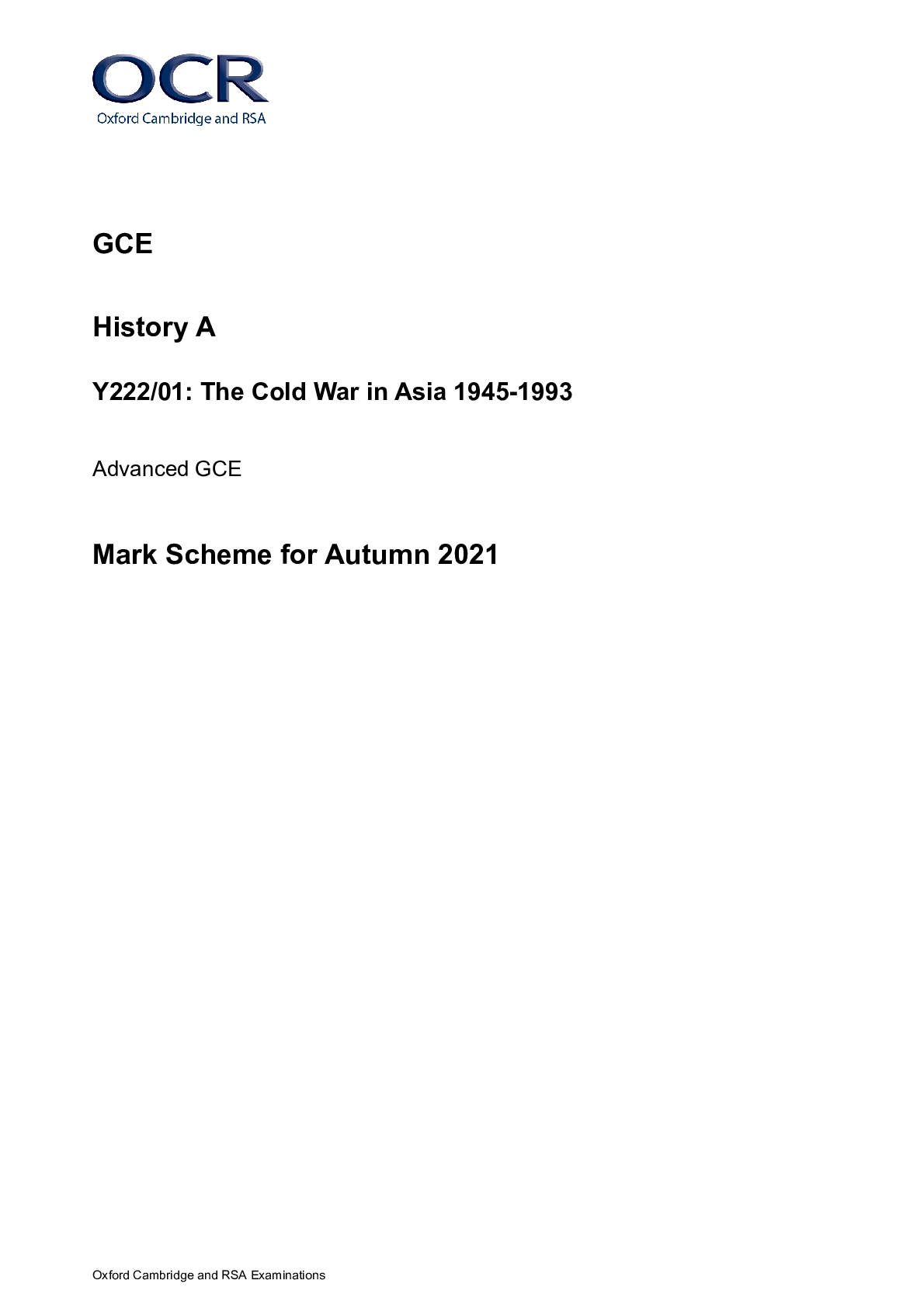
Reviews( 0 )
Document information
Connected school, study & course
About the document
Uploaded On
Oct 07, 2022
Number of pages
12
Written in
Additional information
This document has been written for:
Uploaded
Oct 07, 2022
Downloads
0
Views
41

